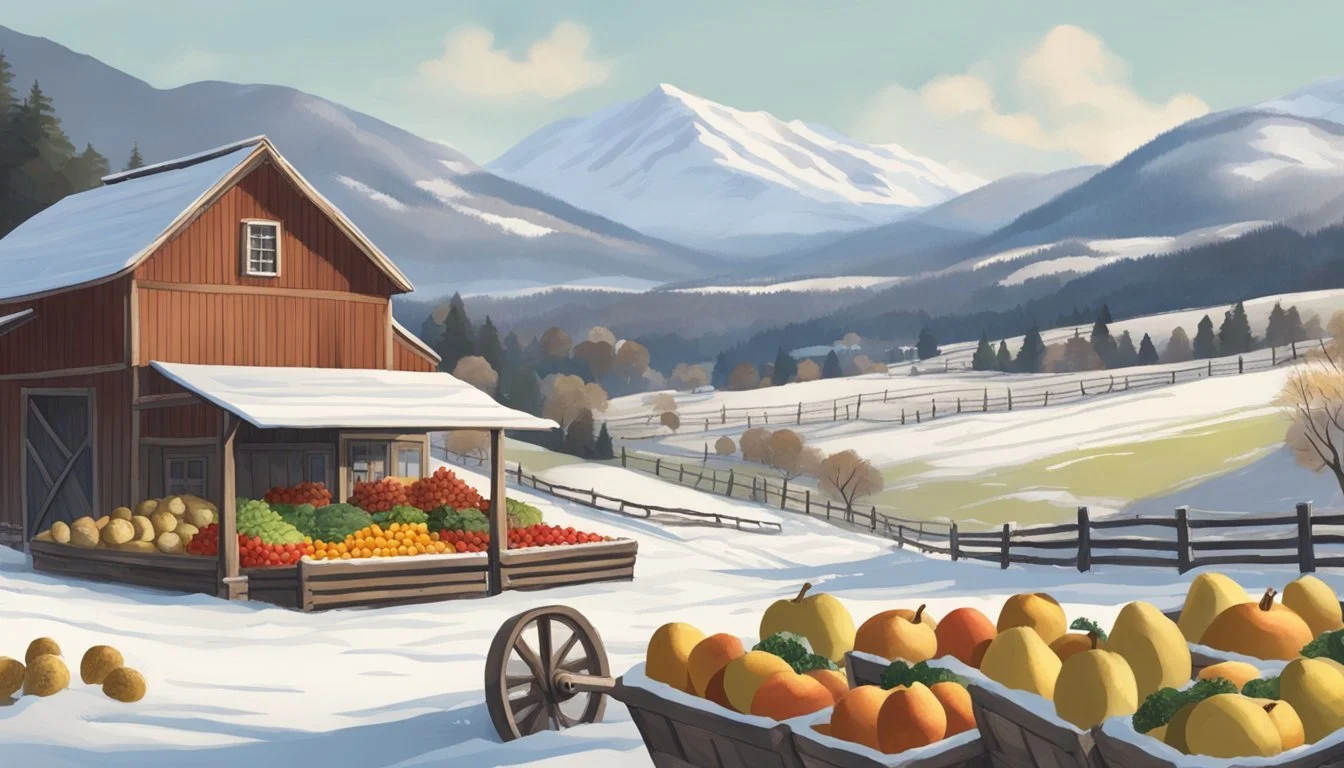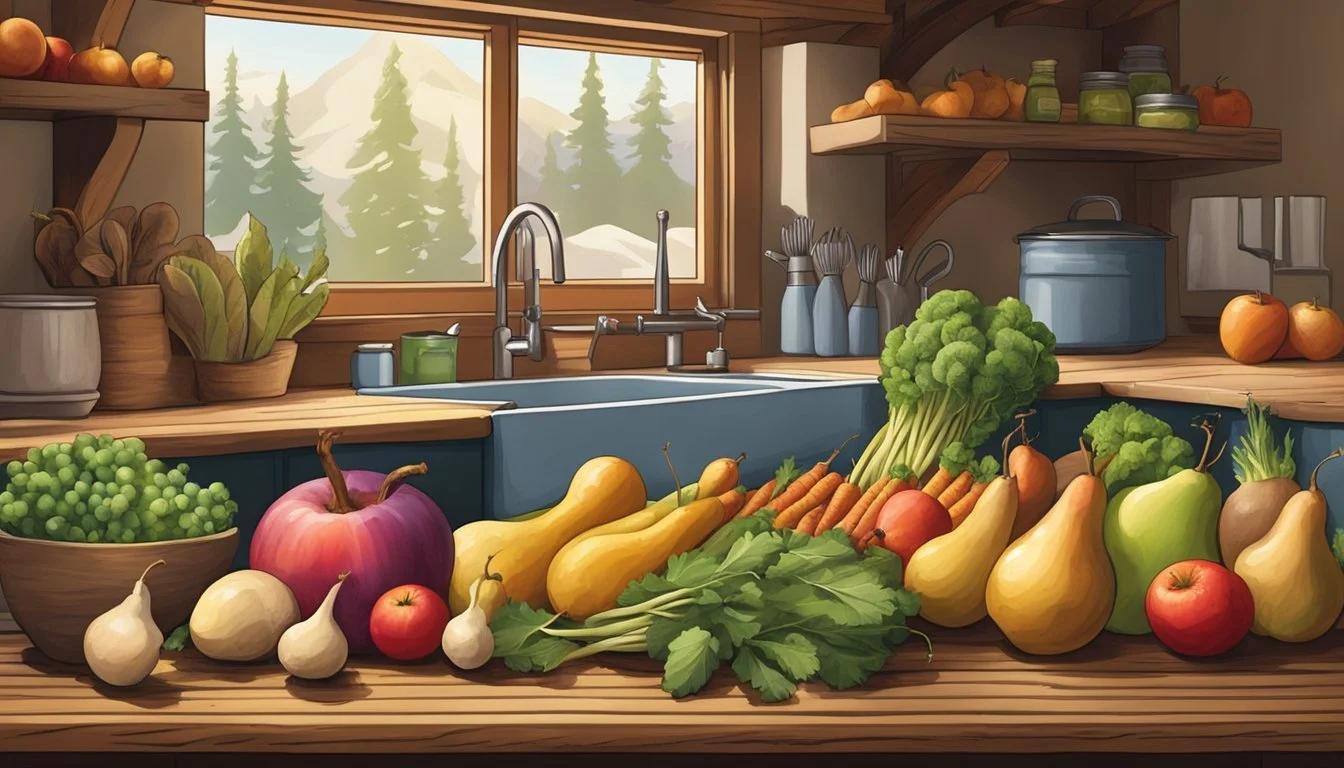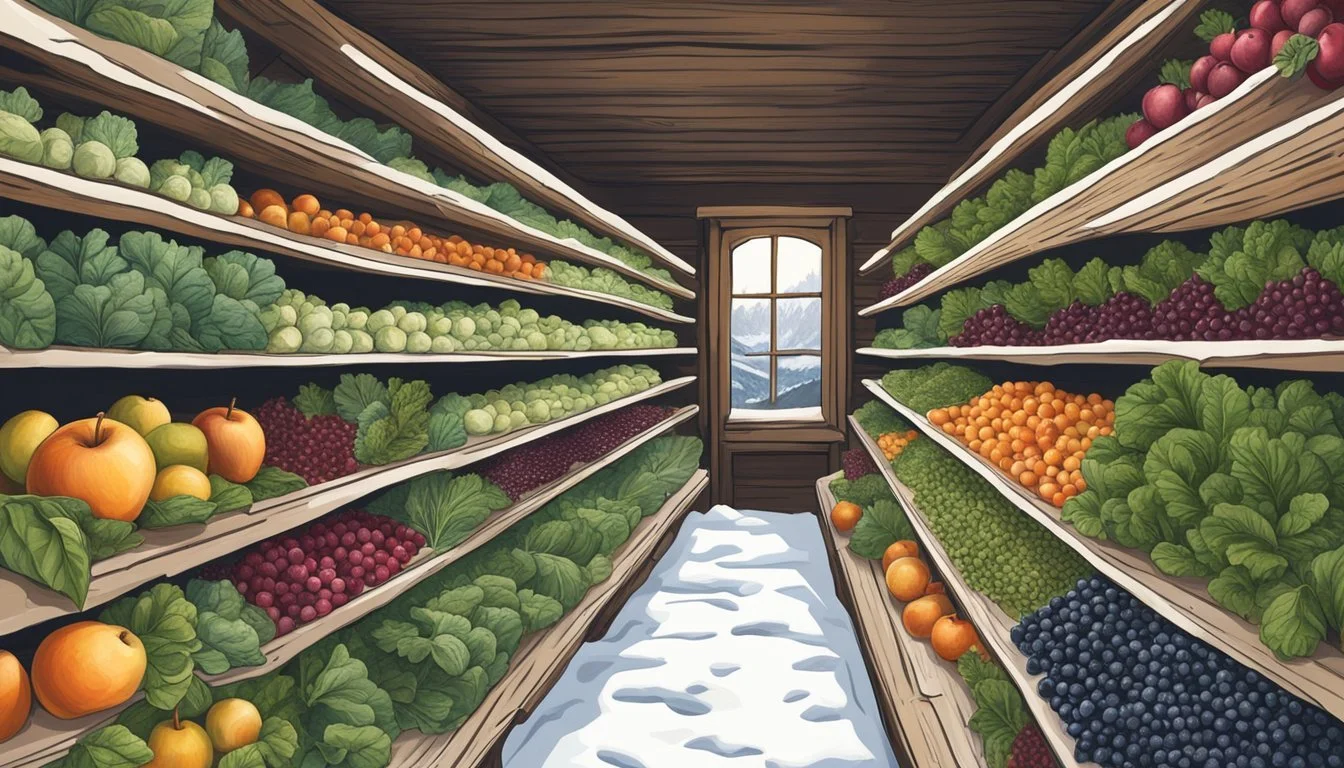Montana Seasonal Fruit & Vegetables in February
What's Fresh Now
This Article is Part of our Montana Seasonal Fruit & Veg Calendar
Montana's diverse climate and fertile soil provide a rich tapestry for agriculture, yet the winter months pose a challenge for fresh produce cultivation. February, firmly within the winter season, typically sees a lull in the availability of locally-grown fresh fruits (What wine goes well with fruit?) and vegetables. Nonetheless, the state's farmers and producers manage to supply a variety of produce during this cold month, thanks to greenhouse growing, storage of root vegetables, and hardier winter crops.
One may not find the abundance of summer fruits like cherries or raspberries in February, but the savvy consumer can still enjoy seasonal offerings. Storage crops such as potatoes, onions, and carrots (how long do carrots last?), which are harvested in less frosty months and stored for use throughout the winter, remain staple vegetables during this time. While the selection of fresh, in-season fruits is more limited, hearty winter vegetables like kale (What wine goes well with kale?) and collards are commonly available and offer nutrition and flavor to winter dishes.
It is important for those interested in supporting local agriculture and consuming seasonally in Montana to understand the cyclical nature of produce availability. Embracing the season means turning to preserved items such as canned fruits, or root vegetables that keep well in storage, to supplement fresh greenhouse-grown produce like greens. By doing so, one not only supports the regional food system but also enjoys the benefits of eating produce suited to the season.
Overview of Seasonal Produce in Montana
Montana's seasonal produce in February is predominantly storage crops and hearty winter vegetables due to the state's colder climate. Access to fresh fruits is limited, with most being cold-storage varieties or imports.
Fruits Available in February
Apples: Several varieties of apples, which were harvested in the fall, remain available in cold storage.
Vegetables Accessible in Winter
Root vegetables: Beets (how long do beets last?), carrots, and potatoes continue to be accessible from winter storage.
Winter squash: Varieties like butternut and acorn are often stocked in February.
Greenhouse-grown produce: Some greens and herbs may be cultivated in greenhouses during the winter months.
It is important for consumers to remember that availability may vary based on local weather conditions and specific regional practices.
Benefits of Eating Seasonal
Eating seasonal fruits and vegetables is a practice that brings with it a manifold of advantages, especially when it's about the produce available in Montana this February. Focusing on the seasonality aligns consumers with the natural growing cycles of the region, ensuring fresher and tastier produce on their tables.
Flavor is significantly enhanced when fruits and vegetables are harvested at the peak of their freshness. Picked at the right time, these foods possess a richer, more robust profile than those that have been shipped over long distances.
From a health perspective, the benefits are substantial. Seasonal produce tends to have a higher nutritional value. Fruits and vegetables contain the most antioxidants and phytonutrients when they are ripe, which is when they are naturally grown and harvested during their appropriate seasons.
Economically, consumers can benefit by saving money, as in-season local produce often comes with a lower price tag. This affordability stems from reduced transportation and storage costs.
Here's a quick glance at what's in season in Montana during February:
Fruits: apples, blood oranges, clementines
Vegetables: various root vegetables and cool-weather leafy greens
Eating according to the seasons is not only beneficial on an individual level but also supports the sustainability and economy of the state. It encourages a deeper connection between the consumer and the region's farming community, thereby fostering a more resilient local food system.
Fruit Highlights
February in Montana sees a limited variety of fruits due to the cold climate, but certain fruits, particularly citrus, remain vibrant and flavorful during this month.
Citrus Varieties
Citrus fruits are a signature produce of February, with lemons and grapefruit readily available. The market also showcases a range of oranges including the robust navel oranges, and the uniquely flavored blood oranges with their deep red flesh.
Lemons: Eureka lemons are common and ideal for both culinary and household uses.
Grapefruit: The ruby grapefruits are plentiful, known for their juicy sweetness and slightly tart flavor.
Oranges: Navel oranges are a staple, while blood oranges are prized for their distinctive color and taste.
Tangerines: Although not as common as other citrus, some varieties may be found.
Core Fruits of the Season
While citrus takes the spotlight, other fruits like pears continue to be seasonal staples in Montana's February markets.
Pears: A variety of pears can be found, with some late-harvested types just reaching their peak sweetness.
Montana's February fruit selection highlights the enduring flavors of the season's citrus while maintaining a presence for hearty staples like pears.
Vegetable Highlights
In February, Montana's vegetable offerings are robust despite the cold climate, with a focus on hearty root vegetables, nutritious cruciferous selections, and resilient leafy greens.
Root Vegetables
Root vegetables thrive in colder weather, storing energy that translates into a bounty of flavor and nutrition. Notable ones this month include:
Carrots: Sweet and crunchy, excellent for raw snacking or adding depth to stews.
Potatoes: Versatile for roasting, mashing, or baking.
Beets: Earthy taste, great for salads, roasting, or pickling.
Turnips: Mild and slightly peppery, suitable for mashes or to accompany meats.
Parsnip: Slightly sweet and nutty, ideal for soups and purees.
Radish: Peppery flavor, perfect for a crisp addition to salads.
Sweet Potatoes: Rich in flavor and vitamins, perfect for baking or as fries.
Cruciferous Vegetables
These are known for their health benefits and robust flavors. They can withstand the chill and are available in Montana during February:
Broccoli: It retains its crisp texture and rich taste when steamed or sautéed.
Cauliflower: Can be roasted whole for a nutty flavor or transformed into rice or mash.
Brussels Sprouts: Best when roasted till caramelized or added to hearty winter salads.
Cabbage: Durable and diverse, used in slaws, soups, or fermented as sauerkraut (how long does sauerkraut last?).
Leafy Greens
Despite the frost, some greens remain stalwart. They offer a fresh balance to heavier winter dishes:
Kale: Hardy and nutrient-rich, it can be sautéed, turned into chips, or tossed in salads.
Spinach: Tender and versatile, suitable for fresh salads or a quick wilt in warm dishes.
Collard Greens (how long do collard greens last?): A traditional favorite, ideal for slow cooking or as wrapped parcels.
Each of these vegetable groups contributes to a varied and healthful diet, with options for countless culinary applications during Montana's winter season.
Cooking and Recipes
Montana's February harvest offers a bounty suited for warming and hearty dishes, as well as fresh, crisp salads. Both fruit and vegetables can be transformed into a variety of dishes to suit any meal of the day.
Salad Inspirations
In February, salads in Montana can be brightened with citrus fruits like oranges and grapefruits, adding a burst of flavor and color. Incorporating root vegetables such as beets and carrots, whether roasted and cooled or raw and shredded, adds a textural contrast and nutritional heft to the salads.
Citrusy Beet Salad: Combine sliced roasted beets with orange segments and a sprinkle of goat cheese.
Carrot Ribbon Salad: Use a peeler to create thin strips of carrots, dress with a lemon vinaigrette, and garnish with parsley.
Warm Dishes for Cold Days
The cold Montana weather calls for comforting warm dishes. Root vegetables like sweet potatoes (What wine goes well with sweet potatoes?) can be turned into satisfying soups or roasted for a simple yet delicious side.
Sweet Potato Soup: A creamy soup spiced with ginger and garnished with a swirl of coconut milk.
Roasted Veggies: Mix an assortment of root vegetables with olive oil, salt, and pepper, and roast until tender.
Sides and Appetizers
Sides and appetizers can start a meal off right or complement the main course. Roasted broccoli and latkes made from shredded root vegetables make for appealing and savory options.
Roasted Broccoli: Tossed with garlic and red pepper flakes, and finished with a squeeze of lemon.
Vegetable Latkes: Combine shredded sweet potatoes and carrots, form into patties, and pan-fry until crispy.
Desserts and Sweet Treats
Desserts and sweet treats featuring local produce can be a delightful end to any meal. Utilizing the available fruits and incorporating them into baked goods or as part of desserts keeps the menu seasonal and special.
Citrus Fruit Tart: Use a variety of citrus fruits atop a creamy filling in a flaky pastry crust.
Carrot Cake: A classic, spiced carrot cake with cream cheese frosting, perfect for a February treat.
Seasonal Eating Tips
In February, Montanans can enhance their dining and nutrition with locally-sourced produce by focusing on storage-friendly fruits and vegetables and taking advantage of local market offerings.
Shopping at Local Markets
Local markets in Montana provide a variety of winter produce that persists even into February. Shoppers should look for root vegetables like beets and carrots, which remain staples in the winter diet. Cool-weather greens, including kale and collard greens, often make an appearance during this month and can be sourced from regional growers. Patrons are also likely to find storage crops such as squash and onions, which are versatile and sustaining. It is advantageous to converse with vendors to understand the origin of the produce and receive guidance on the freshest picks.
Preservation and Storage
Appropriate preservation and storage techniques can ensure that both fruits and vegetables maintain their freshness and nutritional value during February's chill. Here's a quick reference for some commonly found items during this season:
Apples: Store in a cool, dark place or refrigerate to extend freshness.
Root vegetables: Keep in a cool, dark, and well-ventilated area; a root cellar is ideal.
Winter squash: Store in a cool, dry place away from direct sunlight.
Herbs: To extend the life of fresh herbs, they can be dried or frozen.
One should also consider canning or dehydrating seasonal fruits and vegetables to enjoy them well beyond their harvest period. For example, pears and apples can be canned, making them a sweet treat for months to come, while root vegetables like beets can be pickled. Preserve the bounty of February in Montana by utilizing these different storage methods.
Montana's Food Landscape in February
In February, Montana's food landscape is shaped by its cold and snowy winter climate. Local agriculture relies heavily on storage crops and the resilience of hearty winter varieties.
Vegetables: Root vegetables like carrots, potatoes, and onions remain staples, preserved from the fall harvest. Winter squash is also available, offering a sweet and filling option.
Greens: Hardy greens such as kale and spinach can be grown in hoop houses and greenhouses, providing fresh produce even in the heart of winter.
Protein: Livestock farming is less seasonal, making beef and bison (What wine goes well with bison?) readily available year-round. Poultry, including chicken and turkey, are also mainstays of the Montanan diet during this time.
Dairy: Dairy products like cheese and milk are consistently produced by the state’s dairy farms, adding essential variety to the diet.
In the cities and towns, farmers' markets and community-supported agriculture (CSA) programs offer these seasonal items directly to consumers, while local food departments and co-ops ensure a steady supply across the state.
The winter months in Montana may require reliance on preserved, stored, or robust produce capable of withstanding the harsh weather, but they continue to support a diverse and nutritious diet.







